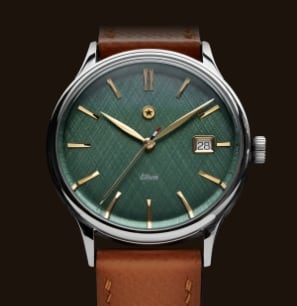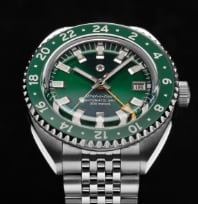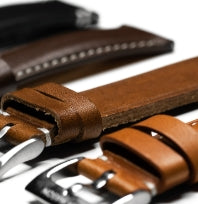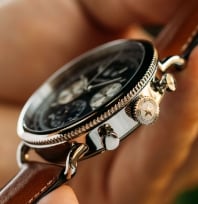Many types of sport watches exist, serving to help us function at our best wherever we are, but special circumstances require special consideration in both form and function. Dive watches go underwater, despite moisture being one of the deadliest things a timepiece can encounter.
Here, Jack Mason will explain what a dive watch is, how it works, and why it is essential.
What Does a Dive Watch Do?
A dive watch serves one main purpose, in that it is a watch designed to function underwater. The first waterproof wristwatch was the Rolex Oyster, produced in 1926 when watches were being made to handle more physical usage. Compared to regular watches, dive watches have specific protective measures taken to keep the internal elements dry.
The two key necessities are that the dive watch both tells and keeps track of time during a dive. However, some watches contain additional features to measure depth, among other things. While a dive watch looks great on your wrist, it also serves a purpose as an essential piece of safety equipment.
What Is a Dive Watch?
A dive watch is any watch built to function underwater. While a dive watch can be worn on dry land, the rest of this guide will assume you are looking to use a dive watch at its most functional, deep underwater. Generally, a few basic metrics must be met to create an effective dive watch.
These include:
-
Water resistance: The minimum resistance needed to designate a watch as water-resistant for diving is 100 meters. At this level, you can go swimming or snorkeling in your gear.
In order to truly create an effective dive watch, a rating of 200 meters or more is recommended. Just because a watch is rated for a certain number of meters doesn’t actually mean it can be taken that deep underwater, but we will explain that more later.
- Luminosity: Underwater, light doesn’t permeate as much as it would otherwise. Whether visibility is occluded because of dim conditions or late-night dives, luminosity markers are a must to keep your watch legible underwater.
This is essential because of our next metric:
-
Time Elapsed Marker: If there’s one reason to bring a dive watch, it’s this: Keep track of the world moving around you. There is nothing more important on a dive, save perhaps ensuring the functioning of your oxygen equipment, than knowing exactly how much time has passed since you’ve been underwater.
For this reason, most dive watches have clear systems which allow you to tell how long your dive has gone on.
International Standard for Organization
The ISO provides a formal test for determining a dive watch, but not all dive watches are tested to ISO 6425 (the specific test outline) standards for a variety of reasons. Because ISO testing must be done on each individual watch, and not just a representative sample, doing so can become prohibitively expensive, though you will have the pleasure of knowing your specific watch has been put to the test.
The ISO tests watches at overpressure, meaning they are able to survive a slightly higher water pressure for periods of time than is stated on the timepiece. The standard also tests for various other durability parameters you may not think about when hunting for a watch to come along with you for a dive.
For example, the watch must remain accurate a day after being exposed to a high level of magnetism. This protects your watch from any other nearby technology. This is helpful whether you’re going on a highly tech-assisted dive or looking to ensure functionality among the numerous sources of magnetism we encounter in our daily lives.
Under ISO standards, the watch also undergoes shock resistance testing, made to represent a one-meter drop onto a hard surface. This durability test is reassuring to have even on land-faring watches, though the thought of intentionally exposing a timepiece to this and all of the above to test it to its limits might be cringe-inducing for some.
Ultimately, while ISO testing is impressive, due to the intensive, costly, and individual nature of the procedure, it’s hardly the be-all and end-all of determining a high-quality dive watch.
How To Wear a Dive Watch
As a fashion piece, you can wear dive watches in most contexts, though we advise you to avoid bringing them to formal events unless you want to give the impression of a James Bond impersonator. Wearing a dive watch is as simple as affixing it on your wrist in much the same manner as you would wear any other watch.
Because you might be wearing a dive watch over a wetsuit, however, many straps meant to be worn with dive watches are built with increased adjustability, which may even include a divers extension to deal with the potential of increased wrist size.
Water Resistance and Watches
Earlier, we said that a watch's stated resistance depth isn’t necessarily the depth a watch can be brought underwater. The reason for this is water pressure. The stated resistance tested refers to the pressure exerted by that depth of water when everything is totally static. However, human beings, especially when engaged in activities like diving or swimming, are anything but static.
Movement causes the protective elements of the watch to be exposed to a greater level of pressure than a given depth of water naturally exerts, which impacts the practical use of a watch relative to its stated water resistance testing.
In practice, a watch with less than 30 meters of resistance should not be exposed to water. 30 meters of resistance makes a watch resistant to light splashes, 100 meters makes a watch appropriate for swimming, and anything above 200 meters makes a watch appropriate for diving.
Protecting a watch from changing water pressure can be complicated, but ensuring water resistance is much easier. The object which performs the arduous task of protecting the inner components of the watch from destructive water is a small rubber ring coated in oil called the gasket.
This o-ring forms a protective seal between the moving elements of a watch and the internal machinery. While it may weaken and dry out over a lengthy period, it’s as simple as going to a watchmaker to repair the piece.
Strapping On
As much consideration goes into the materials used in the manufacture of dive watch wrist straps as goes into the construction of the watch itself. After all, the strap of the watch is exposed to just as much water as the exterior of the case itself.
The all-around strongest material for a dive watch strap is rubber, whose water-resistant properties make them useful as gaskets. Another suitable material is stainless steel. This metal’s overall strength and potential for adjustability are compatible with the fact that some blends, called marine-grade steel, are exceptionally rust-resistant.
While a leather strap is highly attractive on dry land, we recommend avoiding using them on dives as leather does not dry easily and can become damaged or discolored from total saturation. Jack Mason’s dive watches feature quick-release straps, making it easy to dress your watch for any occasion.
Case Study: The Seatrek
We can’t talk about the essentials of a dive watch without offering a real-life example of what a dive watch should be. For this case study, we’re examining Jack Mason’s Seatrek.
Here’s how it stacks up in our list of dive watch essentials:
- Water Resistance: Testing at 300 meters makes the Seatrek well-adapted for deep waters.
- Luminosity: SuperLuminova markings on the indices, hands, and the starting point on the bezel help with reading both the current and elapsed time.
- Time Elapsed Marker: As mentioned before, luminosity markings make it easier to read this marker at any given time. However, while this marker is attached to the bezel, that bezel is unidirectional. This means that it is only possible to increase your perceived elapsed time, making it near-impossible to accidentally overstay your dive if you remain faithful to your timer.
- Strap: The Seatrek comes with a rubber strap, ideal for extended stays in the water, that is made with quick-release pins so that it can be swapped out should you wish to switch to a different kind of rubber strap or change to a metal bracelet or leather band for more formal settings.
- Additional Features: The Seatrek is designed with a screw-down crown, which goes directly into the watch case to reduce the risks posed by both water and dust alike. The 316L stainless steel case is highly resistant to chemicals, promising equal protection for the inner and outer workings of your watch.
One additional feature exists, though it has zero impact on the function or durability of the piece: The exhibition caseback harkens back to the earliest history of diving history, with the inclusion of a bathysphere safely floating in the middle of the peaceful deep seas. All in all, the Seatrek provides a competitive dive watch in function while remaining stylish enough to wear on your wrist at any given time.
Using a Dive Watch
In the final analysis, dive watches are an invaluable tool for those who truly need them and a high-functioning timepiece for those who simply want a little more water endurance in their accessories.
Whether you see yourself scuba diving in the near future or simply wanted to educate yourself about this storied type of watch, we hope you leave with a better understanding of what makes dive watches special.
Sources:
James Bond's Watch Collection I GQ Magazine
What Makes Luminous Watch Dials Glow, a Brief History of Shine | Bloomberg







